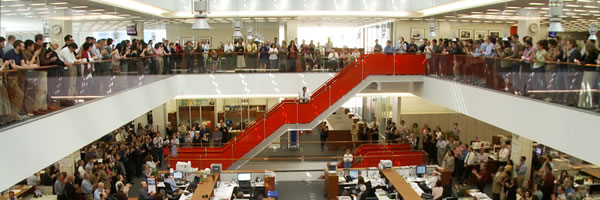Directed by Andrew Rossi
Written by Andrew Rossi and Kate Novak
The death of the newspaper. A headline that we’ve seen many, many times over the past few years. With the growing digital world, the old black and white is becoming more and more of a nuisance to people than a hot commodity. Why would you go out and get the paper outside when you can easily access it on your computer, iPhone, iPad, Blackberry, etc.? It seems that by the time a newspaper grabs hold of a story, a reporter writes it, then it goes to the presses, the mainstream world saw it on Twitter six hours beforehand. So, how does a newspaper not only stay in print and keep their audience, but how do they attract the Millennial Generation?
PAGE ONE: A YEAR INSIDE THE NEW YORK TIMES follows the paper for a year through not only the competition within the paper to land on page one, but the looming threat of bankruptcy that many others have succumbed to. If anyone can be successful, the Times can. Right? The Times has always been synonymous with what a newspaper is. They’ve been pivotal in the history of breaking news from The Pentagon Papers, the recent Wikileaks, and covering the turmoil of the dying paper, all the while wondering if it could happen to them.
The movie follows reporters and columnists as they go about their work writing stories, finding the big news, keeping their sources secret, and trying to keep this company alive. David Carr, a veteran with a very roller-coaster history and colorful mouth, is The Times most outspoken reporter who's highlighted. He believes in the good old-fashioned journalism where you throw yourself into you story, dig deep and produce something memorable and groundbreaking. He's a treat to follow and is not afraid to hurt anyone's feelings. However, even with the most dedicated, there's a tension in the air everyday at work. Will this be the day that I'm let go? Will my job be here tomorrow? Even though they still have a job to do, the "dying paper bug" is always looming in the air adding more stress to an already stressful job.
With this dying art, the documentary delves into answers I never even thought of. Sure, the printed press is succumbing to the online world, but that's not the only reason. Papers use to get their finances not only from selling the paper but from advertisers. However, with the invention of Monster.com, there was no longer a need for the job ads. Then with the invention of Craigslist, classifieds disappeared. So, with money to even run the paper was dwindling, many had no choice but to make cuts. Coupled with the fact their website, where you can read the paper, is no longer offering that luxury for free because the money has to come from somewhere. Nothing is for free.
The Times has the rich history and status as being the pinnacle for a journalist. If you wanted to make it, you wanted to end up at The Times. Even today, The Times still holds a place for the nostalgics of a "simpler" era when reading the news was actually a staple of American culture. There are still many baby boomers that hold on to that nostalgia, not wanting to see the progression into the blogosphere.
PAGE ONE is an intellectual look at the other side of the journalism business. There's much to be discussed whether we really need the printed press anymore since everything is so readily available. Maybe we just hold on because the paper represents something from the past we're not ready to let go yet. And if The Times, considered THE American newspaper, ends up going under, what's next?
Tweet


No comments:
Post a Comment